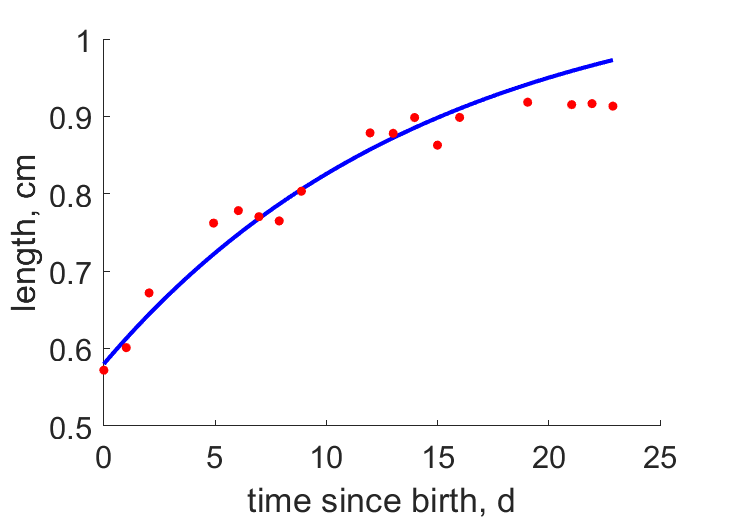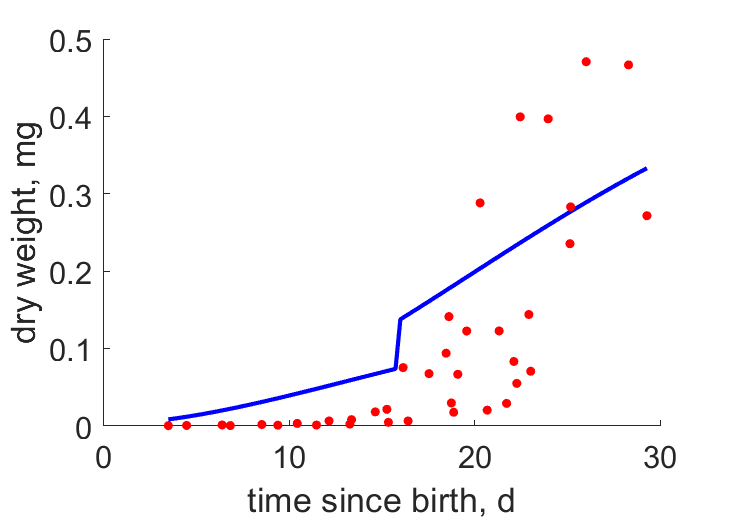Predictions & Data for this entry
| Model: abj | climate: MA, MB, MC | migrate: | phylum: |
| COMPLETE = 2.5 | ecozone: MA | food: biPz | class: |
| MRE = 0.046 | habitat: 0iMp | gender: Hh | order: |
| SMSE = 0.008 | embryo: Mp | reprod: O | family: |
Zero-variate data
| Data | Observed | Predicted | (RE) | Unit | Description | Reference |
|---|---|---|---|---|---|---|
| ah | 1.5 | 1.554 | (0.03577) | d | age at hatch | Pear1991 |
| ab | 3 | 2.702 | (0.09921) | d | age at birth | Pear1991 |
| tp | 15 | 15.73 | (0.04839) | d | time since birth at puberty | guess |
| am | 730 | 734.8 | (0.006546) | d | life span | ADW |
| Lh | 0.09 | 0.08558 | (0.04913) | cm | total length at hatch | Pear1991 |
| Lb | 0.13 | 0.1263 | (0.02878) | cm | total length at birth | Pear1991 |
| Lp | 0.76 | 0.774 | (0.01837) | cm | total length at puberty | Reev1970 |
| Li | 1.2 | 1.29 | (0.0748) | cm | ultimate total length | Beer1964 |
| Ri | 34 | 32.88 | (0.03285) | #/d | maximum reprod rate | Pear1991 |
| JX85 | 0.64 | 0.6414 | (0.002168) | mg dry weight/d | ingestion rate at 0.85 cm | Reev1964 |
Uni- and bivariate data
| Data | Figure | Independent variable | Dependent variable | (RE) | Reference |
|---|---|---|---|---|---|
| tL |  | time since birth | length | (0.02952) | Reev1970 |
| tW |  | time since birth | dry weight | (0.8319) | Reev1970 |
Pseudo-data at Tref = 20°C
| Data | Generalised animal | Ferosagitta hispida | Unit | Description |
|---|---|---|---|---|
| v | 0.02 | 0.01451 | cm/d | energy conductance |
| kap | 0.8 | 0.597 | - | allocation fraction to soma |
| kap_R | 0.95 | 0.475 | - | reproduction efficiency |
| p_M | 18 | 629.3 | J/d.cm^3 | vol-spec som maint |
| k_J | 0.002 | 0.002 | 1/d | maturity maint rate coefficient |
| kap_G | 0.8 | 0.8013 | - | growth efficiency |
Discussion
- length-wet weight relationship: morphology suggests length : width : height = 1 : 0.1 : 0.02
- so V = .002 L^3, probably an over-estimation
- Ww_i = .002 1.2^3 = 8.6 mg; Wd_i = 0.1 mg
- shape of tW-curve strongly suggests that gonads contribute to Wd
- Reproduction efficiency kap_R has been set to 0.95/2 because the species is simultaneous hermaphroditic
Facts
- protandrous hermaphrodite (testes mature before ovaries); internal fertilisation (Ref: Pear1991)
- protandrous hermaphrodite (testes mature before ovaries); internal fertilisation (Ref: Pear1991)
Bibliography